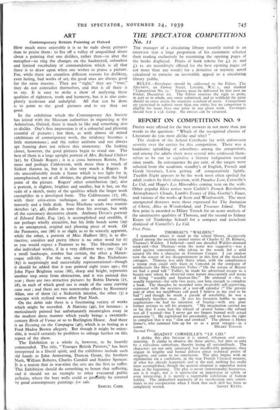ART
Contemporary British Painting at Oxford How much more enjoyable it is to be rude about pictures than to praise them: to fire off a volley of unqualified abuse about a painting that one dislikes, rather than—to alter the metaphor—to ring the changes on the hackneyed, colourless and limited vocabulary of commendation which is all that there is to draw upon when one wishes to praise a picture. For, while there are countless different reasons for disliking, even hating, bad works of art, the good ones are always good for the same reasons. They are " right," they are " true," they do not contradict themselves, and that is all there is to say. It is easy to make a show of analysing these qualities of rightness, truth and harmony, but it is also com-
pletely irrelevant and unhelpful. All that can be done is to point to the good pictures and to say they are good.
In the exhibition which the Contemporary Art Society has joined with the Museum authorities in organising at the Ashmolean, Oxford, there is much to like and something also to dislike. One's first impression is of a colourful and pleasing roomful of pictures ; but then, as with almost all mixed exhibitions of contemporary work, the stridency becomes a little monotonous ; and the rather uniform and not always apt framing does not relieve this monotony. On looking closer, however, the good pictures begin to stand out. The best of them is a large upright portrait of Mrs. Richard Chilver (91), by Claude Rogers ; it is a cross between Renoir, Pas- more and perhaps Coldstream, with more than a touch of Sicken thrown in, but it is also very much a Rogers. It sits uncomfortably inside a frame which is too light for it, unemphasised, not at all obvious, the glowing mouth the focal point of the picture. Rogers' other contribution (92), also a portrait, is slighter, brighter and smaller, but it has, on the scale of a sketch, many of the qualities which the larger work exemplifies in a developed form. The Coldstreams (17, 18), with their criss-cross technique, are as usual arresting, masterly and a little drab. Ivon Hitchens sends two routine sketches (47, 48), duller in tone than his average, but with all the customary decorative charm. Anthony Devas's portrait of Edward Eade, Esq. (30), is accomplished and credible, if not perhaps wholly attractive, but his little beach scene (29) is an unexpected, original and pleasing piece of work. Of the Pasmores, one (86) is so slight as to be scarcely apparent, while the other, a portrait of Miss Hulbert (87), is as dis- tinctive, sensitive and pretty (there is no other word for it) as you would expect a Pasmore to be. The Moynihans are also individual works, if in a very different way ; one (74) is a small landscape, sombre but certain, the other a Manet- esque still-life. For the rest, one of the Ben Nicholsons (85) is surprisingly and successfully representational—though it should be added that it was painted eight years ago ; the John Piper Brighton scene (88), sharp and bright, represents another step away from abstraction, and it was painted this year ; there are two attractive pictures by Robin Darwin (27, 28), in each of which good use is made of the same curving cane seat ; and there are two noteworthy efforts by Rosemary Allan, one of them (2) a Sickertish interior, the other (3) a seascape with stylised waves after Paul Nash.
On the debit side there is a fascinating variety of works which might be recorded. A Nativity (49), for instance: a meticulously painted but unfortunately meaningless essay in the modern dress manner which yearly brings a twentieth- century Birth of Venus or so to Burlington House. And there is an Evening on the Campagna (46), which is as boring as a Ford Madox Brown allegory. But though it might be enjoy- able, it would certainly be profitless to enlarge further on this aspect of the show.
The Exhibition as a whole is, however, to be heartily commended. The title, " Younger British Painters," has been interpreted in a liberal spirit, and the exhibitors include such old hands as John Armstrong, Duncan Grant, the brothers Nash, William Roberts, Charles Cundall and Stanley Spencer. It is a truism that in war-time the arts are the first to suffer. This Exhibition should do something to lessen that suffering, and it should set an example to other evacuated public galleries, where the bare walls could as profitably be covered by good contemporary paintings for sale.
SAMUEL CARR




































 Previous page
Previous page